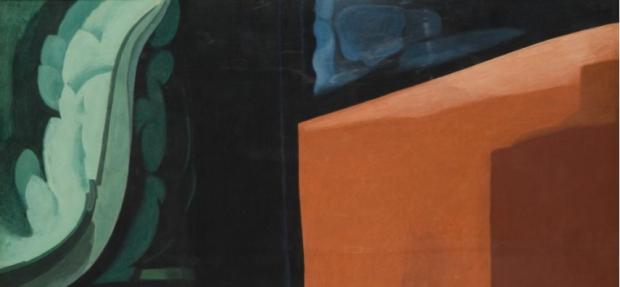What It Meant to Be Modern
What It Meant to Be Modern, 1910-1965
John Marin, Oscar Bluemner, Stuart Davis, Charles Sheeler, and Charles Burchfield at the Burchfield Penney
The Burchfield Penney show in the rooms usually reserved for just Charles Burchfield works currently features watercolors by five modern artists: John Marin, Oscar Bluemner, Stuart Davis, and Charles Sheeler, along with Burchfield. Works for the most part from the Karen and Kevin Kennedy collection. The show is called What It Meant to Be Modern, 1910-1965.
To generalize, based on the works on display, what it meant conceptually was abstraction. What it meant visually—what you saw before you could think about what it meant—was flattening. The radical modernist departure from classical three-dimensional perspective rendering. As invented by the Greeks and codified by the Renaissance, and maintained in constant usage since the Renaissance, until the late 19th century, when the usage began to be contested. The representation of forms and figures in space the way they actually appear. Supposedly.
Though artists in other traditions eschewed or neglected or otherwise did without three-dimensional perspective rendering, and happily enough for their artistic productions. Such as through the whole of the Middle Ages. Or in Egypt prior to the Greek classical innovations, or countless other non-European cultural situations prior or since. Or in kids’ art.
(What is it that is so wonderful about kids’ art? What makes it so great? Above all, the complete absence of modes and manners writer James Herndon would have characterized as “the way it spozed to be.” Which is to say, classical learned lessons about the “right” way to represent figures and forms in space.)
All the flat art traditions differed from the classical tradition—again to generalize—not just in flatness, but in an iconic character somehow, that non-classical tradition art possessed, and classical tradition art by and large did not. Classical tradition art—by the middle of the 19th century at least—had devolved into basically art as representation. The flatness tradition art—including kids’ art—was art as icon. Sacred object, or quasi-sacred. Mana object almost. Visual mana. But representation not the primary concern.
Among the items on show, flattening effects—and basic-stage abstraction—most prominent in works by Charles Sheeler and Stuart Davis. Davis’s handsome little harbor scene with vaguely personified small craft fishing boat looking eager to get out on open water and at the day’s labors. Or a simplified formalist commercial-industrial cityscape. Sheeler’s monotone blocks of pure geometrical forms architectural scenario, featuring monumental silo forms reminiscent of Buffalo waterfront grain silos. Or more-advanced-stage abstraction in a brickwork and rooflines depiction with prominent cubist inspiration fragmentation effects.
Whereas, terminal-stage abstraction in several colors of the fall season gestural works by Marin. Splashes of forms and color in the vein of Kandinsky. While for Bluemner, a more pictorial brand of abstraction, with a northern romanticist sensibility. Some mystery house in the forest scenes. A little dour, a little gloomy. And a kind of centerpiece Bluemner work, an enormous moon with aura concentric rings around it, and below, ambiguous possible human figures in ostensible lunar cult semi-ecstasy poses. Vein of Stravinsky, his Rite of Spring.
Burchfield—as always—somewhat anomalous in his interests and in his approach. Not particularly interested in the whole perspective matter, or for that matter abstraction. Burchfield’s consuming interest was vitalist. About how everything in the universe pulsates with life force. To express which vision and message he had major recourse to symbolism, a sub-genre of abstraction.
One of the Burchfield paintings is of what looks like the moon—with concentric rings around it again—as a kind of pendulum weight suspended menacingly in the night sky, over an otherwise peaceful houses and gardens scene. But not the moon this time but the sun. The work is called Sun Setting in a Bank of Smoke, from 1917. The concentric rings, industrial-era atmospheric pollution effects.
So much for the old romanticism. What it meant to be modern for Burchfield, really to be postmodern. In corollary with the vitalist thematic, to perceive and express in his work the industrial world threat to the natural environment. A century beforehand.
It didn’t make him cynical, however. Another Burchfield nature work, featuring the actual moon this time, with extensive brilliant aura, illumining a dense stand of dandelion full seed heads, set to disperse at the least breeze, is stunningly beautiful. A late work, from the early to mid 1960s.
The What It Meant to Be Modern exhibit continues through June 23.

